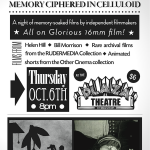
On Labor Day, my wife and I decided to finally go see Senna at a movie theater. We were just about to go see it at the Landmark Sunshine Theater, when we realized we could stay nearer to our hood and see it at the Film Society of Lincoln Center, saving a trek and supporting an awesome organization closer to us. I’d been there before for a panel presentation, but hadn’t seen a film in the new Elinor Bunin Munroe Film Center (yes, of course, we’ve been to their other theaters over the years).
How surprised we were when we entered the theater and realized we weren’t getting seated in either of the two new, supposedly amazing theaters, but in the Amphitheater – which is basically a little room with glass walls and six or so rows of bench style seating with a gigantic tv screen in front. This is where I’d been to a panel, and the room works fine for such an event, but… we were here for a movie. What the FSLC likes to call a film. What they were, in essence, built to celebrate as an art form.
Senna is no ordinary documentary. It is (supposedly) a tour de force doc about a powerful sportsman in a sport that kinda demands the big screen (Formula 1 racing), big noise, treatment. Not something I wanted to watch from the comfort of my living room, or someone else’s for that matter. (oh, and btw, yes, I watch many films on my laptop, etc, but by choice, and at a different price point, and not at a temple to film, and…).
We reluctantly took our seats, it was about half full, which isn’t bad for a Holiday evening. But, due to a big design flaw, my wife’s feet couldn’t touch the floor. So, not only is this not stadium seating, but it’s not even standard theater seating, or standard…anything seating. She rested her feet on her bike helmet and we began debating our options – see this in a less than ideal space (to be charitable) or walk out and try to see it on a real movie screen in the future. Well, our decision-making process had barely gotten started when the usher came in to let us know the film would be starting soon, but there would be some light issues due to the design of the space and to let them know if it bothered us.
??
That was enough to get us to leave. They gave us a refund after pointing out that we’d paid cheaper – $10 instead of $13 – because of the theater. I decided the poor ticket seller had nothing to do with this absurdity and just smiled as I got my refund. We left. We fumed about the state of cinema-going.
What the heck has gone wrong here? How does a film society, not just any society, but THE Film Society of Lincoln Center thinks it’s acceptable to show a film this way and charge admission? I’m not going to bother to point out all the reasons this isn’t acceptable – I can’t believe that any of the cinephiles I know at FilmLinc would possibly think this is acceptable, and I’m sure they know the reasons why. I know that the current leadership wasn’t there when this theater was designed, so I’m not blaming them for not realizing that Mr. Fancypants Architect designed them a no-good amphitheater that wasn’t practical for showing films. But I do think all of them should take a little retreat, perhaps to a cinema like The Paris, and have a big talk about how they might better showcase this “important art” we call film.
I am guessing that showing films in the amphitheater is a purely financial decision. These new theaters were expensive, the economy is pretty bad and nonprofits always need a way to make more money, and I can understand that need, but this is not the way to do it. Frankly, I’m also surprised that any distributor would let their film be shown this way. I’m all for shaking up how we think of seeing films, and I think we all need to be open to new ideas, which is why I love the ReRun, for example. But this doesn’t feel like a bold experiment to me. It just feels like putting a film where it isn’t meant to go.
In all the reading I’ve done about the Center, I never read that the amphitheater was meant for showing films. I heard about it being used for talks, for special presentations and such. I could see it being used in any number of ways, but not as a first-run, arthouse theater. Give me some lectures, even with some film examples being shown. Give me screenings with running discussions. Showcase some of the great art-world films that usually only get seen in a gallery. Heck, I’d love to see something like The Clock in there (well, maybe not, the gallery here was more comfortable). But please, stop showing films like this, and if you must, please make it much more clear on your website that the film won’t be seen in a real theater so cinemaniacs don’t waste their time and money.
I’m off to do that tonight, finally going downtown to Landmark. I’d rather not. I am a huge fan of the FSLC and their new leadership and staff. I want to spend every one of my cinema dollars at their Center. I’ll still go when I’m 100% sure the film won’t be in the amphitheater, and I’ll go to that space for other, non-cinema, events. People don’t take constructive criticism well in this business, but if they read this, I sure hope they do this time.
(Photo from Film Society of Lincoln Center website)







